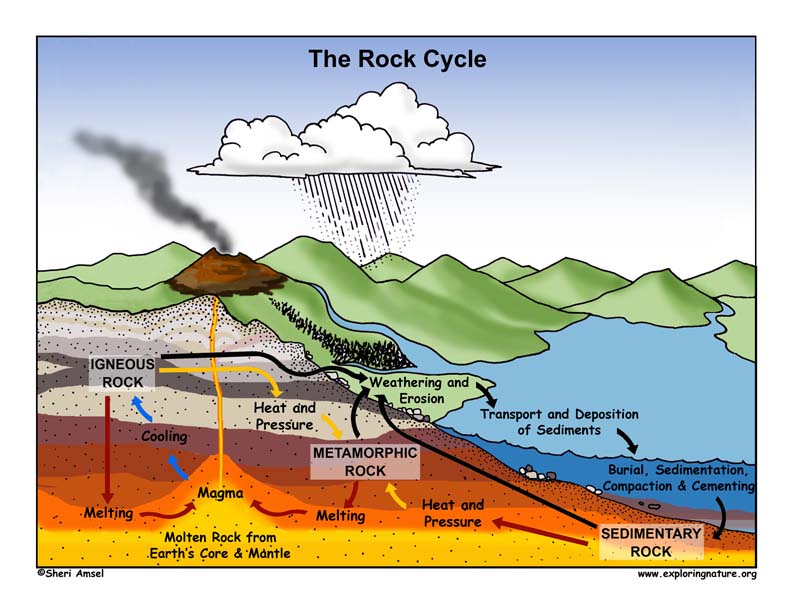

_________________________________________________________________________________________________________________________________________________________
Disciplinary Core Ideas
ESS1.C: The History of Planet Earth
• Local, regional, and global patterns of rock formations reveal changes over time due to earth forces, such as earthquakes. The presence and location of certain fossil types indicate the order in which rock layers were formed. (4-ESS1-1)
Performance Expectations
Students who demonstrate understanding can:
4-ESS1-1. Identify evidence from patterns in rock formations and fossils in rock layers for changes in a landscape over time to support an explanation for changes in a landscape over time. [Clarification Statement: Examples of evidence from patterns could include rock layers with marine shell fossils above rock layers with plant fossils and no shells, indicating a change from land to water over time; and, a canyon with different rock layers in the walls and a river in the bottom, indicating that over time a river cut through the rock.] [Assessment Boundary: Assessment does not include specific knowledge of the mechanism of rock formation or memorization of specific rock formations and layers. Assessment is limited to relative time.]
_________________________________________________________________________________________________________________________________________________________
Use the Template and Resource Links to Fulfill NGSS
l. Goals:
Essential Questions:
NGSS Note: Think, question, entertain ideas.
ll. Introductory Activities to Assess Prior Knowledge
A. Simple Activities - that assess students’ understanding of patterns of rock formation and fossils.
B. Brainstorming Session
Question: What are some Earth events that happen very quickly and others that occur very slowly.?
1. Break students down into groups of 3-4.
2. Ask students to generate a list of Earth events that happen very quickly and others that occur very slowly.
3. Discuss
lll. New Knowledge - Text
A. Read about Earth's events happening slowly and quickly.
Rock Identification & the Rock Cycle
Examples of Models (depicts the concept expressed in the reading):
Ask students to look at the models of the rock cycle and the formation of a thunderstorm and discuss fast and slow Earth processes.
Students can create their own model with: Rock Formation Coloring
Vl. Next Generation of Science Standards (NGSS) - Grade 4
Disciplinary Core Ideas
ESS1.C: The History of Planet Earth
• Local, regional, and global patterns of rock formations reveal changes over time due to earth forces, such as earthquakes. The presence and location of certain fossil types indicate the order in which rock layers were formed. (4-ESS1-1)
Science and Engineering Practices
Constructing Explanations and Designing Solutions
Constructing explanations and designing solutions in 3–5 builds on K–2 experiences and progresses to the use of evidence in constructing explanations that specify variables that describe and predict phenomena and in designing multiple solutions to design problems.
• Identify the evidence that supports particular points in an explanation. (4-ESS1-1)
Crosscutting Concepts
Patterns
• Patterns can be used as evidence to support an explanation. (4-ESS1-1)
Connections to Nature of Science
Scientific Knowledge Assumes an Order and Consistency in Natural Systems
• Science assumes consistent patterns in natural systems. (4-ESS1-1)
Students who demonstrate understanding can:
4-ESS1-1. Identify evidence from patterns in rock formations and fossils in rock layers for changes in a landscape over time to support an explanation for changes in a landscape over time. [Clarification Statement: Examples of evidence from patterns could include rock layers with marine shell fossils above rock layers with plant fossils and no shells, indicating a change from land to water over time; and, a canyon with different rock layers in the walls and a river in the bottom, indicating that over time a river cut through the rock.] [Assessment Boundary: Assessment does not include specific knowledge of the mechanism of rock formation or memorization of specific rock formations and layers. Assessment is limited to relative time.]
Common Core State Standards Connections
ELA/Literacy
W.4.7 Conduct short research projects that build knowledge through investigation of different aspects of a topic. (4-ESS1-1)
W.4.8 Recall relevant information from experiences or gather relevant information from print and digital sources; take notes and categorize information, and provide a list of sources. (4-ESS1-1)
W.4.9 Draw evidence from literary or informational texts to support analysis, reflection, and research. (4-ESS1-1)
Mathematics
MP.2 Reason abstractly and quantitatively. (4-ESS1-1)
MP.4 Model with mathematics. (4-ESS1-1)
4.MD.A.1 Know relative sizes of measurement units within one system of units including km, m, cm; kg, g; lb, oz.; l, ml; hr, min, sec. Within a single system of measurement, express measurements in a larger unit in terms of a smaller unit. Record measurement equivalents in a two-column table. (4-ESS1-1)
When you research information you must cite the reference. Citing for websites is different from citing from books, magazines and periodicals. The style of citing shown here is from the MLA Style Citations (Modern Language Association).
When citing a WEBSITE the general format is as follows.
Author Last Name, First Name(s). "Title: Subtitle of Part of Web Page, if appropriate." Title: Subtitle: Section of Page if appropriate. Sponsoring/Publishing Agency, If Given. Additional significant descriptive information. Date of Electronic Publication or other Date, such as Last Updated. Day Month Year of access < URL >.
Amsel, Sheri. "Grade 4 - 4-ESS1 Earth’s Place in the Universe" Exploring Nature Educational Resource ©2005-2024. December 13, 2024
< http://www.exploringnature.org/db/view/Grade-4-4-ESS1-Earthrsquos-Place-in-the-Universe >

